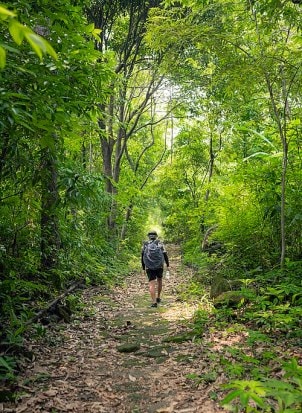The David Scott Trail is one of Meghalaya’s most storied trekking routes, a path that threads through pine forests, rolling meadows, and sleepy Khasi villages while carrying echoes of colonial history and indigenous resistance. The trail, which runs roughly sixteen kilometres from Mawphlang to Lad Mawphlang, is today a moderate, half-day trek, but in its origins, it was part of a much longer and more ambitious route built by the British in the early nineteenth century to connect Assam with Sylhet, now in Bangladesh. What remains is a scenic fragment of that old horse and mule track, preserved by the Khasi communities whose ancestral lands it crosses, and treasured by trekkers for its blend of history, nature, and quietude.

The story of the trail begins with its namesake, David Scott, a British administrator posted in Northeast India during the early 1800s. Scott was a political agent tasked with establishing efficient routes for communication and trade between the British strongholds in Assam and the plains of Sylhet. The Khasi Hills, though beautiful, were a barrier to this ambition—rugged, forested, and ruled by local chieftains, or syiems, who were independent and proud. Scott and the British authorities began work on a bridle path that would cut across these hills, making travel and transport of goods faster. Between 1827 and 1829, the path was formalised into a mule track, linking several Khasi villages. But what the British saw as progress, the local chiefs viewed as intrusion. The imposition of taxes and the demand for control over the passes led to the uprising of 1829–1833, spearheaded by U Tirot Singh, the Syiem of Nongkhlaw, who fought fiercely against British encroachment. Though the British ultimately prevailed, the war became a symbol of Khasi resistance, and the David Scott Trail still stands as a reminder of that turbulent encounter between empire and autonomy.
Walking the trail today is to experience a landscape that has barely changed in two centuries. The trek begins in the village of Mawphlang, about twenty-five kilometres from Shillong, known for its sacred groves—dense, ancient forests protected by religious belief. From the trailhead, the path undulates through grassy slopes, crosses sparkling streams, and dips into cool valleys before climbing again towards the misty ridges. The terrain is gentle for the most part, though certain sections are rocky or slippery, especially after rain. Along the way, one encounters remnants of the past: a moss-covered stone tomb said to date back to 1843, inscribed with the words “to a child fondly called Camilla”; old arch bridges built of dressed stone; and stretches of the original cobbled pathway still visible beneath the grass.
The trail passes through meadows where ponies graze, pine forests that scent the air with resin, and quiet villages like Laitsohma, where time seems to move unhurriedly. Midway, a suspension bridge spans a river valley—a replacement for the old bridge that was washed away in floods years ago. The Wahtham Valley opens up in a broad sweep of green, a good place to rest and watch the clouds drift across the horizon. It is this constant alternation between open landscapes and shaded forest that gives the David Scott Trail its rhythm and its calm, inviting even casual walkers to pause, breathe, and listen to the wind.
The flora along the trail is diverse: wild orchids, ferns, mosses, and herbs used in traditional Khasi medicine grow in profusion. The path is part of an ecological corridor linking the Khasi Hills with Bangladesh’s lowland forests, and birdwatchers often spot bulbuls, thrushes, and warblers. The best time to walk the trail is between October and April, when the weather is clear and the ground firm. During the monsoon, from June to September, the route becomes more difficult—streams swell, leeches abound, and the path can be dangerously slippery—but it is also at its greenest, alive with the smell of wet earth and pine.
Though the trek can be completed in about five or six hours, it is best begun early in the morning from Mawphlang to allow time for breaks and photographs. There are no shops or facilities along the way, so trekkers are advised to carry water, snacks, and basic supplies. Hiring a local guide is highly recommended—not only for navigation but for the stories and cultural insights that bring the landscape to life. Many of the forests around Mawphlang are community-protected, and guides help ensure that visitors respect local customs, including restrictions on littering and the sanctity of sacred groves.
The trail ends at Lad Mawphlang, where the path meets the main Shillong–Cherrapunji road. Most trekkers arrange for a vehicle to pick them up here, but the more adventurous sometimes continue on to explore nearby attractions such as the living root bridges of Nongriat or the waterfalls around Sohra. For many, however, the David Scott Trail itself is the destination a journey that combines natural splendour with a sense of walking through history.
Few treks in India manage to feel both intimate and monumental, but this one does. It is a short walk, yet layered with centuries of memory: the hum of British ambition, the defiance of U Tirot Singh, the timeless rhythm of Khasi village life, and the unbroken beauty of the eastern hills. The David Scott Trail may no longer be the trade artery it once was, but in its quiet persistence, it has become something deeper—a living museum of Meghalaya’s landscape and spirit.


